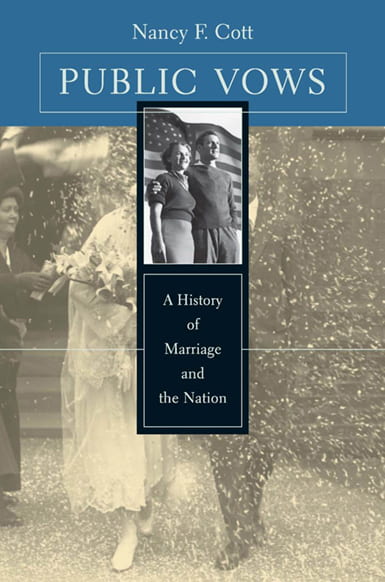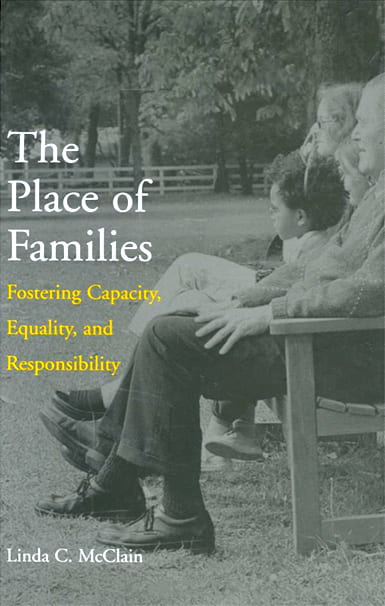
In Review
Family’s Changing Terrain
By M. Christian Green
“Happy families are all alike; every unhappy family is unhappy in its own way,” Leo Tolstoy tells us in the celebrated opening sentence of his novel Anna Karenina, thus attesting to the centrality and diversity of families in his time and our own. Discourse concerning the family has in recent years focused greatly on contrasting “traditional” families with “alternative” families, as societies around the world have grappled with the question “What is the family?” Churches and religious traditions have not been strangers to these discussions—charged as they are with the powers to bless and bury, marry and mourn, thus shaping the traditions and transitions that support and sustain the families in their midst. The increasing prevalence of divorce and nonmarital cohabitation, of single mothers and absent fathers, of same-sex marriage and non-marriage, along with new technologies for courtship and procreation, have continually brought these issues to the fore in society and culture, religion and politics, and law and public policy.
In the three years that I have sojourned at Harvard Divinity School as a visiting lecturer on ethics, I have twice taught a course titled “What Is the Family? Religious and Ethical Perspectives,” through which my students and I have sought to map the changing terrain of marriage and family. In that course, several recent books assessing the history and current state of the family have been particularly informative and provocative of debate. These include Harvard historian Nancy Cott’s Public Vows: A History of Marriage and the Nation, Linda C. McClain’s The Place of Families: Fostering Capacity, Equality, and Responsibility, and Martha Albertson Fineman’s The Autonomy Myth: A Theory of Dependency—the latter two volumes written by feminist legal theorists and family law professors whose work has, on occasion, brought them to themes at the intersection of law and religion. While these treatises on the family do not resolve the perennial discussions of family forms and diverse definitions, they each suggest something of the significance of the family for religion, politics, and society as a whole.

Public Vows
One thing that scholars of the family know—and to which recent political battles over the family amply attest—is that the issue is never just about the family. Cott’s Public Vows provides a sweeping history of the way in which definitions and understandings of the form and functions of the family are inextricably linked to the political and economic development of the United States. Throughout that history, marriage and family have been seen as private relationships with public value. Much of the thrust of marriage law, marriage theology, and public policy in the United States has been in the direction of a particular model of family organized around the family based on monogamy, consent, and, until very recently and in just a few jurisdictions, on heterosexuality. But beyond organizing the domestic relations of husbands and wives, fathers and mothers, and parents and children, this marital ideal has also been central to constructions of race, to the assimilation of Native Americans and myriad waves of immigrants to the dominant political and civic ethos, and to the organization of labor and the economy.
If the nation’s founders borrowed much of John Locke’s liberal political theory in setting up the nation’s government and republican institutions, it appears that they borrowed Locke’s political and theological understandings of marriage as well. There was, to be sure, an emphasis on voluntary consent and contractual freedom, but there was also a preservation of monogamy and headship, the latter preserved in the laws of coverture against the biblical background “one flesh” doctrine which merged a wife’s legal status and personal identity with that of her husband’s. Adherence to this monogamous model of marriage was a political as well as a personal virtue, with Native Americans, African American slaves, immigrants, Mormons, and others perceived to be indisposed to, ineligible for, or incapable of monogamy perceived as derelict, degenerate, and in need of domestication. This attachment to the monogamous ideal seems increasingly quaint in the contemporary political context, in which political pundits have joked of the 2008 Republican Party presidential candidates that only the Mormon, former Massachusetts governor Mitt Romney, has limited himself to one wife! Yet, for much of our history, marriage and monogamy have been intertwined in a single standard to which all were to adhere.

The Place of Families
An important shift came in the twentieth century, in which, as Cott describes it, the economic utility of marriage supplanted political and moral strictures as the foundation for the modern architecture of marriage. The postwar economy of the mid-twentieth century was famously— at least as depicted in the “happy housewife” appliance ads that still get a screening in gender studies courses—based on the domestic, and largely feminized, consumption of the white, middle-class, suburban oikos. At the same time, the public consumer mentality was increasingly coming to “colonize the lifeworld,” as social theorist Jürgen Habermas would have it, of the private affective relationships of the family. The feminist revolution, the sexual revolution, the divorce revolution—all would coalesce to produce a greater degree of choice in family formation and dissolution than Locke ever could have imagined in arguing for the voluntary family.
New choices necessitate new laws, a topic that Linda McClain takes up in The Place of Families—while not departing entirely from the emphasis on virtue, character, and citizenship that Cott identifies as so central to the political and marital ideals of the United States. A family law professor with a master’s degree in religion from the University of Chicago, McClain begins with the question, “How does a liberal constitutional democracy produce citizens with the capacities for responsible democratic and personal self-government?” The family, she argues, plays an important role in this. Her question is whether and how the government and other institutions should support the family in this function. The references to capacity, equality, and responsibility in McClain’s subtitle suggest the contours of this project. The first of the capacities to be developed is that of autonomy, which McClain as a liberal feminist defends robustly against more gynocentric, relational, or cultural feminists who emphasize relationship over autonomy. McClain’s autonomy is not an atomized autonomy, but an associational autonomy, aimed at cultivating virtue, providing care, and realizing the goods of intimate association—the things that marriage and family are for. All of these are functions in which the family deserves public, civic, and perhaps even governmental support.
At the same time, there are areas of marital and familial life in which government should restrain itself from intervention or even preference, and instead assume a posture of “toleration.” These become the basis for her recommendation of three rationales for toleration—an anti-compulsion rationale that avoids the evil of forced beliefs and conduct, a jurisdictional rationale with respect to personal and private areas not properly the domain of government intervention, and a diversity rationality that would counter the single standard thrust that Cott identifies in her history of marriage. The emphasis on tolerance is likely to prove unpalatable to readers for whom mere toleration is likely to seem minimalist and peevish, if not outright unjust, but it does suggest a measure of equality, to be balanced with responsibility in potentially a variety of family forms, including same-sex forms, whose legitimacy McClain defends.

The Autonomy Myth
The question of family forms and functions is one that has put McClain in dialogue with her fellow feminist family law professor, Martha Fineman, on a number of occasions, particularly since the publication in 2003 by the respected legal research and reform body known as the American Law Institute (ALI) of its first-ever treatise on the state of family law, titled Principles of the Law of Family Dissolution. The very title of the report conveys to those outside the law something of the grim terrain covered by family law, an area of law second only to criminal law in seeing human nature in its more agonistic and destructive forms. The controversy surrounding some of its proposed recommendations is equally appreciable to nonlawyers. Perhaps the most controversial chapter of the report was one that proposed to ascribe the status of marriage to relationships that seem to function like marriage. One rationale for such a proposal is strictly voluntarist and contractual, in that such a schema would affirm and validate the “close relationship” that people choose. Another rationale comes closer to the one for which Fineman has been a leading advocate—namely, recognizing and giving legal status and support to relationships of care and dependency. In contrast to McClain’s liberal feminism, Fineman represents a more gynocentric or relational strand of feminism. In earlier writings Fineman, a frequent participant in the work of the Center for the Study of Law and Religion at Emory University, has sought to defend motherhood against the “neutering” of gender equality, to define the mother-child dyad (absent fathers) as the primal and legal family, and to critique models of liberal autonomy as diminishing rather than conducing toward relationships of care. Fineman calls for a “recasting of the social contract” and for law and government to recognize and support such relationships of care. It is a visionary and far-reaching proposal that would have considerable implications for women, particularly single mothers taking care of children or dutiful daughters taking care of aging relatives, such care still remaining largely the province of women in a gendered division of labor and care that persists even in the so-called “postfeminist” era.
One of the most interesting arguments against the ALI’s proposal for ascribing something like marital status to what would otherwise be nonmarital relations is, as McClain notes, that such ascription is illiberal insofar as it disregards people’s own choices about the characterization and implications of their arrangements. A cohabiting heterosexual couple could find themselves much more bound together in the law than they in fact wish to be. After all, some people may have their reasons for choosing not to marry. A same-sex couple might find themselves coerced into accepting something less than the full legal (and, for some, sacramental) status that “marriage” implies. Indeed, the ALI’s apparent throwing up its hands in the definition of marriage has been described as the state “getting out of the marriage business,” tossing these important relationships, which may in fact involve significant degrees of care, dependency, and expectations of reliance and mutuality to the whims and whimsies of our fickle voluntary choices and existing contractual schemas. The triumph of contract over status and consumer attitudes toward our intimate associates over relational security and stability could rock the very foundations of marriage, family, and many other close relationships. And it should not go unnoticed that churches have apparently been emulating the state in this regard, as seen in the recent discussion and then tabling by the Episcopal Diocese of Massachusetts of a proposal to stop blessing marriages, heterosexual or same-sex, as a response to turmoil over same-sex marriage in that denomination.
So, what is the family in the various tales that these family treatises tell? In the contemporary United States, marriage, the foundational act of the family is certainly a matter of voluntarism and choice. Some marry; some marry more than once; some marry not at all. It is also about identity both personal and social, as the same-sex marriage movement attests vigorously. In that sense, it is not merely a private and personal choice, but one that is highly dependent on, and demanding of, public and social recognition. In an era of geographic mobility, a weak social safety net, and diminished social connections, marriage and family are also crucial units for the provision of care to those with various types of dependency. Marriage and family meet multiple needs. Families may be more diverse than ever—and there are those who argue that families in the United States have always been more diverse than the single-standard ideal admits—but the legal, religious, political, and moral significance of families, in their travails and in their resilience, are timeless and universal.
M. Christian Green, who has been at HDS for three years as Visiting Lecturer on Ethics, will become the Alonzo L. McDonald Family Senior Lecturer at Emory University and Senior Research Fellow in Emory’s Center for the Study of Law and Religion.
Please follow our Commentary Guidelines when engaging in discussion on this site.

